Entry into Jerusalem (11:1–11)
As they approached Jerusalem and came to Bethphage and Bethany at the Mount of Olives (11:1). Bethphage (meaning “house of early figs”) is located closer to Jerusalem than Bethany and is near the summit of the Mount of Olives. Bethany is on the southeastern slopes of the Mount of Olives.
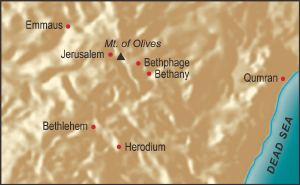
BETHPHAGE, BETHANY, AND JERUSALEM
BETHANY
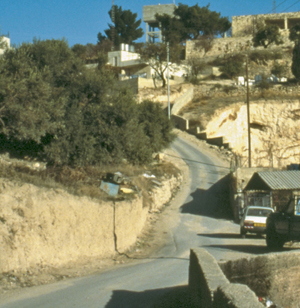
The location of the ancient road from Bethany to Bethphage.
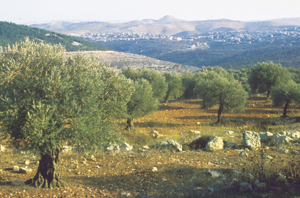
The countryside near Jerusalem.
You will find a colt tied there, which no one has ever ridden. Untie it and bring it here (11:2). Jesus has walked everywhere else in his ministry except when he crossed the lake in a boat. Riding a colt on this last stage of his journey becomes an enacted symbol that communicates forcefully and dramatically that Jesus is the king of Israel. (1) He impresses the animal as a king would. “The Lord needs it” is the same phrase used to justify David’s eating of the bread of the Presence (cf. 2:25). (2) He impresses the use of a young donkey that has never been ridden. This fits a royal motif. It is an animal suitable for a sacred purpose and worthy of a king.249 According to the Mishnah, no one else may ride a king’s horse.250 (3) The disciples saddle it with their own garments. When Jehu is anointed king, every man took his garment, put it under him on the steps, and proclaimed, “Jehu is king” (2 Kings 9:12–13). This entry into the city may have fueled the charge brought against Jesus to Pilate that he was king of the Jews (Mark 15:2).
A donkey would be apt for a king, but Mark does not identify the animal. Riding “a colt” may express humility. This idea is drawn from Zechariah 9:9, though Mark makes no explicit reference to this verse. He does use the word for the donkey’s foal that appears in the LXX version of Zechariah 9:9. A later rabbinic tradition interprets Daniel 7:13 and Zechariah 9:9 to mean that if Israel is worthy, the Messiah will come upon the clouds; and if not, he will come on a donkey.251 We cannot know if this tradition was current in the first century.
As they untied it (11:4). Twice Mark mentions that the colt is bound and must be untied. This factor may purposely link to Genesis 49:10–12, where the one to whom the scepter of Judah belongs binds his colt to the choicest branch and washes his garments in wine.
Others spread branches they had cut in the fields (11:8). The practice of spreading branches occurred at various festivals—at the Feast of Dedication and the Feast of Tabernacles.252 It fits the joyous nature of the Passover celebration.
Hosanna! Blessed is he who comes in the name of the Lord! (11:9). “Hosanna” is a Greek transliteration of the Hebrew Hôšî‘âh nā’, which means “save” or “help, please.” Jesus’ eye-catching entry into Jerusalem parallels other triumphant entries into the city. After Simon destroyed the last shred of opposition to Maccabean rule by capturing the citadel in the city, “the Jews entered it with praise and palm branches, and with harps and cymbals and stringed instruments, and with hymns and songs, because a great enemy had been crushed and removed from Israel” (1 Macc. 13:51). Josephus reports that in the rebellion against the census of Quirinius, Menahem broke into King Herod’s armory on Masada and “returned like a veritable king to Jerusalem” and became a leader of the revolution laying siege to the palace.253 Jesus’ entry may have set up expectations of a kingly rule, but his purpose and actions starkly contrast with those of military ambitions.
Jesus entered Jerusalem and went to the temple. He looked around at everything (11:11). Jesus’ surveying the area and then leaving recalls Malachi’s prophecy of the Lord visiting his temple.254
Worshipers entered and exited the temple grounds through the Double Gate in the south wall.255 From a broad plaza one climbed thirty steps that alternated between steps and landings to force an unhurried, reverent ascent. The steps are estimated to have been 210 feet wide. The arch and the original lintel of the Double Gate are still intact, though partially concealed by the remains of a tower built by the Crusaders. Inside the vestibule were domes, sixteen feet in diameter, chiseled with beautifully painted floral and geometric designs. One climbed the tunnel passageway and exited in the temple esplanade. The Royal Stoa lay behind.
The Triple Gate was used by priests and to reach the storerooms for the wine, oil, and flour. In between these gates stood a bathhouse for ritual purification and a council house. Three such courts are mentioned in the Mishnah: a court at the gate of the temple mount, at the entrance to the temple court, and in the Chamber of Hewn Stone (m. Sanh. 11:2).
The Temple Incident and the Cursing of the Fig Tree (11:12–25)
Then he said to the tree, “May no one ever eat fruit from you again” (11:14). Pliny, the Elder, observed, “The fig tree is also the only tree whose leaf forms later than its fruit.”256 Since it sets its fruit before producing leaves, once it has broken into leaf, it should have produced fruit.
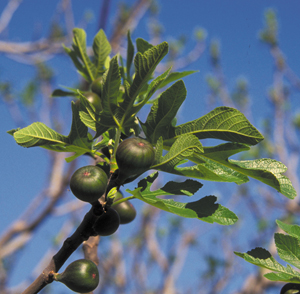
FIG BRANCH
Jesus’ odd cursing of a fig tree—the only miracle that brings death and not life—becomes an enacted parable. Jeremiah’s outburst against the temple provides the backdrop for understanding it. God forbids the prophet to make any intercession for the people (Jer. 7:16) and then says that his “wrath will be poured out on this place, on man and beast, on the trees of the field and on the fruit of the ground, and it will burn and not be quenched” (7:20). The parable of the tenants of the vineyard makes the same point: The tenants [of the temple] have borne no fruit to give to the owner and are subsequently destroyed.
Fruitfulness was a symbol of Israel’s covenant relation to God. At one point, God delighted in Israel because it was like seeing the early fruit on the fig tree (Hos. 9:10). The blighted tree in a land where trees are scarce becomes a symbol of God’s judgment.257 Withered to the roots, there is no hope for this fig tree’s renewal.
Jesus … began driving out those who were buying and selling there (11:15). Those buying and selling are trafficking in animals for the sacrifices. The priestly aristocracy’s wealth and influence are directly attributable to their control of the fiscal affairs of the temple. Since Jesus throws out both buyers and sellers, something more than dishonest profiteering provokes him.
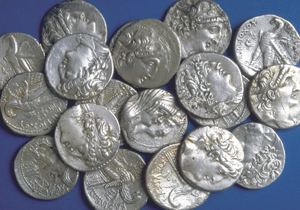
TYRIAN SHEKELS
Archaeological discoveries suggest that the temple market was inside the Royal Stoa and not spread out all over the so-called court of the Gentiles.258 The Royal Stoa was at the intersection of the paved streets of Jerusalem. The main street that ran the length of the Tyropoeon Valley headed north along the western wall of the temple was directly accessible via the steps leading down from Robinson’s Arch to the markets on the streets below. The main part of the Stoa was a long rectangular Hall of Columns built in the design of a basilica, with 162 columns in four rows stretching the length of the hall. Josephus describes it as “a structure more worthy to be spoken of than any other under the sun.”259 Mazar concludes that the Royal Stoa contained a smaller market that “served primarily for commerce in the cultic provisions for the Temple.”260
We should not suppose that the changing of money and the selling of sacrificial objects compromised the holiness of the temple. Some kind of market was necessary for the daily operation of the temple. The biblical requirement of offering unblemished sacrifices to God necessitated having a supply of sacrificial animals on hand, a means of inspecting the animals for disqualifying blemishes, and a monetary exchange for pilgrims. This activity does not take place within the sacred space of the sanctuary.
He overturned the tables of the money changers (11:15). Tables were set up in the outer courts three weeks before Passover to receive the annual half-shekel tax required of every Jewish male (Ex. 30:11–16).261 This tax funded the daily sacrifices for the atonement of sin.262 For a modest commission, money changers exchanged inadmissible local currencies for the sanctioned Tyrian shekel used to pay the tax. Jewish authorities were forbidden to mint silver coins, and they adopted the Tyrian shekel because of its high quality and because it did not flaunt Rome’s dominion over Israel. These coins, however, had an image of the god Melkart (Herakles) on the obverse and an eagle with the inscription, “Tyre the holy and inviolable,” on the reverse.
The benches of those selling doves (11:15). Doves were the staple sacrifice of the poor who could not afford animals for sin offerings (Lev. 5:7). They were also used for the purification of poor women after child birth (12:6, 8; Luke 2:22–24), for men and women who had a bodily discharge (Lev. 15:14, 29), and for poor ex-lepers (14:21–22). An incident recorded in the Mishnah describes a time when the cost of doves was exorbitant (two golden dinars for a pair of doves). Fearing that the poor would not bring their offerings at these prices, Rabbi Simeon, the son of Gamaliel, gave a ruling that only one offering would suffice for the five that were required. The bottom fell out of the price in one day to half a silver dinar (1 percent of the original cost).263
He … would not allow anyone to carry merchandise through the temple courts (11:16). This translation is misleading. It is perhaps based on Josephus’s report that no one was allowed to carry vessels into the sanctuary264 and a passage from the Mishnah that forbids using the temple as a shortcut.265 The text, however, says that Jesus prevents them from carrying a “vessel through the temple.” “Vessel” is used in the LXX for the sacred temple vessels for the bread of the Presence, lamp oil, and incense censers (see Isa. 52:11: “the vessels of the LORD”).
The people involved are probably stunned by the power of Jesus’ moral indignation. It is a modest clash since it does not spark the intervention of the Roman soldiers, who monitor the crowd from their post above the temple court in the Antonia Fortress (contrast Acts 21:34). Jesus’ actions in the temple market, therefore, do not seem to be some attempt to reform the temple practice. Overturning and driving out evoke images of judgment rather than reform. Those involved will soon set right their tables and pick up the scattered money. There is little comparison to what Jesus did and the purification of the temple by Josiah (2 Kings 23) or Judas Maccabeus (1 Macc. 4:36–59).
He is not clearing commercial space for prayer. There is no evidence that the outer court was thought of positively as the place where Gentiles could worship. On the contrary, it was thought of as an area beyond which Gentiles could not go. The balustrade surrounding the sanctuary had warning signs cautioning any Gentile against proceeding any further, threatening death to violators (see Acts 21:27–30). There was plenty of room for Gentiles to pray in the outer court, and clearing a place for them to pray does not remove the barrier that kept them from the sacred place.
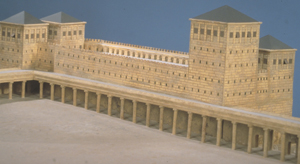
THE ANTONIA FORTRESS
A model of the Roman fortress showing the temple precincts in the foreground.
But you have made it “a den of robbers” (11:17). This citation from Jeremiah condemns the Jewish leaders for turning God’s sanctuary into a sanctuary for bandits. The den was the hideout where robbers retreated after committing their crimes—their place of security and refuge.
Therefore I tell you, whatever you ask for in prayer (11:24). The temple was regarded as the place where prayer was particularly effective; thus, when one was not in the temple, one should orient oneself toward it in prayer.266 This belief is reflected in the high priest’s prayer in 3 Maccabees 2:10: “And because you love the house of Israel, you promised that if we should have reverses and tribulation should overtake us, you would listen to our petition when we come to this place and pray.” Lament over the effect of the temple’s destruction on Israel’s prayer is recorded in the Talmud:
R. Eleazar said: From the day on which the Temple was destroyed, the gates of prayer have closed, as it says, “Yea, when I cry for help, He shutteth out my prayer” (Lam. 3:8)…. R. Eleazar also said: Since the day that the Temple was destroyed, a wall of iron divides between Israel and their Father in Heaven; as it says, “And take thou unto thee an iron griddle and set it for a wall of iron between thee and the city” (Ezek. 4:3).267
Jesus’ statement implies that the effectiveness of prayer has nothing to do with the temple or its sacrifices. He will later affirm the judgment of a teacher of the law who says that loving your neighbor as yourself “is more important than all burnt offerings and sacrifices” (12:33).
By what authority are you doing these things? (11:28). The priestly hierarchy take seriously any threats against the temple. Not only is it the holy place where God dwells, it provides the priestly caste its livelihood and status and has an enormous impact on the whole Jerusalem economy. Josephus reports that prior to the war against Rome, the leading citizens of Jerusalem arrested a coarse peasant named Jesus, son of Ananias. He had pronounced woes day and night against the city, the people, and the sanctuary. After arresting him, the magistrates were still unable to silence him. In hopes of doing away with him once and for all, they brought him before the Roman governor, who judged him to be a maniac and had him flayed to the bone.268
John’s baptism—was it from heaven, or from men? Tell me! (11:30). Answering a question with a counterquestion was a normal debate tactic that changed the power equation. Jesus will answer their question only on his terms—after they answer him. It puts him “in the driver seat.”269 The priests cannot afford to declare John a charlatan and alienate his pious supporters, nor can they openly endorse him and risk accrediting other charismatic prophets who followed after him—like Jesus. The implication is that John was an eschatological prophet whose divine authority had bypassed institutional lines of command, such as the temple hierarchy. The same holds true for Jesus. His action in the temple is that of a prophet directed by God and not a conventicle of priests and teachers of the law.